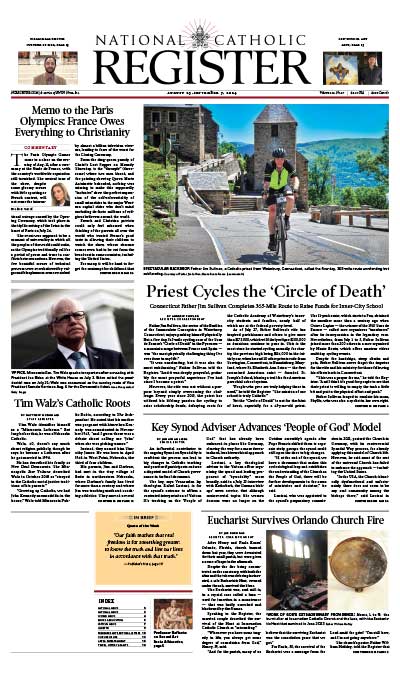The National Eucharistic Congress Is Over — Now What?
EDITORIAL: In a word: mission.

The pilgrims have returned home, the stage in Lucas Oil Stadium has been dismantled, and the Blessed Sacrament has been reposed in the tabernacle.
Now what?
It’s a fair question. And it’s likely on the minds of many following the conclusion of the 10th National Eucharistic Congress last week and over the weekend.
After all, the congress, which followed a 6,000-mile-long, cross-country National Eucharistic Pilgrimage and drew more than 50,000 Catholics to Indianapolis, was the apex of the National Eucharistic Revival that has been renewing the Eucharistic belief and devotion of Catholics across the country for the past two years.
As those who attended could tell you, the congress was a high point in the spiritual lives of so many — a truly life-changing event.
But after such a colossally high mountaintop experience, it’s fair to ask what we all are supposed to do now — or if a letdown is about to occur.
Not to worry. Because even though the congress has concluded, the National Eucharistic Revival is far from over.
In fact, the question of what comes next can be answered with a single word: mission.
Sharing the love we have received from our Eucharistic Lord, really and truly present in the Blessed Sacrament, will be the focus of the Revival’s concluding “Year of Mission.” The goal of this year will be to send “on-fire Catholics out to share Christ’s love ‘for the life of the world,’” through service, evangelization and catechesis.
This connection between the Eucharist and mission isn’t something the Revival’s organizers cooked up. Instead, it’s at the heart of the very logic of the Eucharist. As St. Augustine teaches us, “If we receive the Eucharist worthily, we become what we receive” — namely, self-giving love that longs to pour itself out, just as Christ did on the cross.
In fact, so central is this connection that Pope Benedict XVI taught in Deus Caritas Est that “a Eucharist which does not pass over into the concrete practice of love is intrinsically fragmented.” This love, he writes, can be commanded precisely because it has first been given.
The connection between receiving the Lord’s love and going out on mission is also at the heart of Pope Francis’ call for each member of the faithful to become “missionary disciples.” Issued in Evangelii Gaudium, the spiritual blueprint of his papacy, Francis describes an unbreakable, reinforcing dynamism between drawing close to Jesus and sharing his love with others. Called to be “Spirit-filled evangelizers,” this “joy of evangelizing always arises from grateful remembrance” — a remembrance that occurs most powerfully in the Eucharist, the memorial of Our Lord’s sacrifice for us.
Our pastors teach about the connection between the Eucharist and mission because it is how the first disciples of Christ experienced it. To see this, we can look to the Gospel scene that served as the inspiration for the National Eucharistic Pilgrimage: the Road to Emmaus.
On that journey, the Risen Lord walks with two disciples, explaining the Scriptures and sharing his presence, their hearts “burning within” them, before sitting down for a meal. And what did his disciples do after Jesus revealed his identity to them and vanished from their midst? “They set out at once and returned to Jerusalem,” recounting what had taken place and how Jesus “was made known to them in the breaking of the bread.”
Our local Catholic Church has walked with Christ along the pilgrimage routes and has sat down to spend time in his presence at the Congress. And now, we too are called to return to our own Jerusalems and share his Eucharistic love through word and deed.
Of course, the National Eucharistic Revival has been demonstrating this connection between Eucharistic discipleship and mission since it started in 2022. Pilgrimage stops included service to the poor and visits to the imprisoned and infirm, while the Revival inspired everything from catechetical resources on the Eucharistic basis of Catholic social teaching to evangelizing musicals.
But now we’re invited to be even more intentional: to engage in those “concrete practices of love” that Benedict XVI spoke of and to ask the question, “How will we live out this call to Eucharistic mission?”
The opportunities are boundless. Perhaps we will be drawn to step out in faith and share what Jesus has done in our own lives with a non-Catholic friend. Or perhaps we will be motivated by the Lord’s love to serve the poor and the marginalized in a new way. Or maybe we will simply rededicate ourselves to loving our families more selflessly and completely.
The most important thing is to do something — to let the love received through the Eucharist have a place to go.
But, of course, just as Eucharistic devotion blossoms into mission, so too is our ability to share Christ’s love dependent on constantly abiding in him, especially in the Eucharist. The Revival has not been a one-and-done moment. It is a call to revitalize our Eucharistic faith and live it out each and every day: to participate in Mass more fully and faithfully, to prioritize spending time with the Lord in Eucharistic adoration, and to confess Christ’s Real Presence in the Eucharist with more clarity and conviction.
As the Second Vatican Council taught, the Eucharist is the source and summit of the Christian life. And the National Eucharistic Revival has been — and will continue to be — an invitation to place this great sacrament at the center of our lives, so that we can more fully receive Christ’s love and more completely share it with others. All that’s left for us to do is respond.
- Keywords:
- eucharistic congress
- indianapolis















